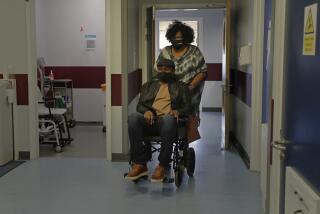AIDS Virus Can Linger in Body Without Symptoms
BOSTON — The AIDS virus can remain in a person’s body for five years or longer without producing disease although it can still be transmitted to other people, doctors at the Centers for Disease Control said today.
The findings indicate that simply because a person who was exposed to the virus years ago has not shown any symptoms of the disease does not mean he or she cannot infect someone else.
It also underscores the importance of screening tests for blood donors now being implemented for acquired immune deficiency syndrome, the often-fatal condition that cripples the body’s defenses against disease.
The study findings will appear in Thursday’s edition of the New England Journal of Medicine.
Long Time Without Symptoms
“The important thing is the fact that the virus can be found in individuals over a long period of time without apparent symptoms,” said Paul M. Feorino, chief of the CDC’s virology section in the AIDS branch.
“This is perfectly consistent with other viral infections,” said Feorino, the report’s primary author. “Some viruses, such as herpes, remain in a person’s body for as long as they live.”
The study analyzed 25 people who transmitted AIDS through blood transfusions and six AIDS victims who caught the disease after receiving blood transfusions.
“We conclude that infection with (the AIDS virus) may be persistent and asymptomatic for years,” the report concluded.
Length of Time the Point
Feorino cautioned that the report is not meant to frighten people about the possibility of contracting AIDS from blood transfusions. He said that of the 3 million people who receive blood transfusions each year, fewer than 100 contract the deadly disease.
“The point is not the problem with transfusions but the fact that these individuals carried the virus for this length of time,” he said in a telephone interview.
As of April 29, the CDC recorded 9,953 cases of AIDS in the United States, with the incidence of the disease increasing in all high-risk groups, such as homosexuals, intravenous drug abusers and hemophiliacs.






